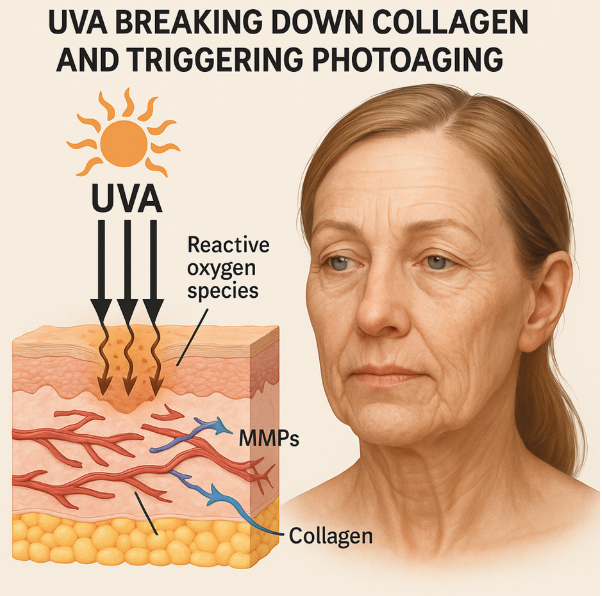Skin aging can be broadly categorized into intrinsic aging and extrinsic aging. Among the extrinsic factors, “photoaging” caused by ultraviolet (UV) radiation is considered the most significant contributor to accelerated skin aging. In particular, UVA (Ultraviolet A) rays have a longer wavelength that penetrates beyond the epidermis into the deep dermis, damaging collagen and leading to decreased skin elasticity and the formation of wrinkles. In this article, we will explore the molecular mechanism by which UVA breaks down collagen within the skin, the resulting structural changes, and the role of skin boosters in combating photoaging.
- Characteristics of UVA and Its Penetration Pathway in the Skin
UVA has a wavelength of 320–400 nm and accounts for approximately 95% of the UV radiation that reaches the Earth’s surface. While UVB primarily affects the epidermis, UVA penetrates deeper into the dermis, causing long-term and cumulative damage. Due to this property, UVA directly impacts structural proteins within the dermis, making it a major contributor to skin deterioration over time.
- The Role of Collagen and Structural Damage Induced by UVA
Collagen comprises approximately 70–80% of the dermis and serves as the primary support matrix that maintains the skin’s firmness and tensile strength. Type I collagen is predominant and works together with elastin to maintain the skin’s flexibility and resilience. However, UVA exposure stimulates dermal fibroblasts, which activate collagen-degrading enzymes while simultaneously inhibiting collagen synthesis, ultimately weakening the skin’s structural integrity.
- Activation of Reactive Oxygen Species (ROS) and Matrix Metalloproteinases (MMPs)
Upon UVA exposure, there is a rapid increase in reactive oxygen species (ROS) within skin cells. These ROS activate the MAP kinase signaling pathway, which leads to the induction of the transcription factor AP-1. AP-1 upregulates the gene expression of matrix metalloproteinases (MMPs), particularly MMP-1 (collagenase-1), which directly degrades type I collagen. Additional MMPs, such as MMP-3 and MMP-9, are also activated and contribute to the breakdown of elastin and other structural proteins, further accelerating the loss of skin elasticity.
- Imbalance Between Collagen Synthesis and Degradation and Its Consequences
In healthy skin, collagen synthesis and degradation remain balanced. However, increased ROS levels due to UVA disrupt this equilibrium. Collagen degradation becomes dominant, while fibroblast-mediated collagen synthesis is suppressed, leading to a net reduction in dermal collagen. This causes structural weakening of the skin, which manifests externally as wrinkles, sagging, and reduced elasticity. In particular, elastin degradation results in diminished skin recoil and contributes to a rough and thickened skin texture.
- The Link Between Photoaging and Inflammatory Response
UVA exposure and the resultant ROS generation also stimulate inflammatory responses in the skin. Increased secretion of inflammatory cytokines such as IL-1, IL-6, and TNF-α creates a chronic inflammatory state that further accelerates the degradation of collagen and elastin. These inflammatory mediators also influence melanocyte activity, promoting pigmentation disorders and uneven skin tone, both common features of photoaged skin.
- Collagen Repair and the Role of Skin Booster Treatments
In skin that has been damaged by photoaging, stimulating new collagen production is essential. However, UVA-induced fibroblast dysfunction impairs the skin’s natural regenerative ability, making active intervention necessary. Skin booster treatments involve direct delivery of hyaluronic acid, amino acids, and regenerative growth factors into the dermis, thereby reactivating fibroblasts and enhancing collagen production.
Skin boosters administered via mesotherapy techniques—using microinjections to deliver active ingredients into the dermis—are effective for regenerating skin and restoring elasticity. These treatments also help improve wrinkles, skin thickness, and tone, making them indispensable in treating various aspects of photoaging.
- Prevention and Management: The Importance of UV Protection
Ultimately, the most effective way to prevent UVA-induced collagen breakdown and skin damage is through thorough UV protection. Consistent use of sunscreens with high SPF and PA ratings, along with physical barriers such as hats and sunglasses during outdoor activities, is strongly recommended. For already photoaged skin, regular skin booster treatments and antioxidant care are vital for creating an optimal regenerative environment.
The process by which UVA promotes collagen degradation lies at the heart of the photoaging mechanism. The induction of oxidative stress and activation of MMPs damages key structural proteins such as collagen and elastin, resulting in decreased elasticity and wrinkle formation. To both prevent and reverse this process, rigorous sun protection and proactive aesthetic treatments such as skin boosters are essential. When combined, these strategies support the long-term maintenance of healthy, firm, and youthful skin.


